It is the second episode in Kodak Agfa’s series of Egypt’s Fossil and Climate Change Museum in Fayoum’s Wadi El-Hitan protectorate in 2017.
In the first episode or part, we checked quickly the history of Egypt’s Wadi El-Hitan protectorate and its very fossil and climate change Museum in the heart of Fayoum’s desert. We also knew a lot about when whales swam and walked the land of Fayoum tens of millions of years ago or in other words when the desert was a part of a vest ocean.
I think it is a reason to reshare the famous Fayoum UFO because it is so beautiful.
 |
| Fayoum's Fossil and Climate Change Museum aka Fayoum UFO |
Now this post is more about when the desert of Fayoum was a huge forest and dinosaurs roamed the earth but before that, I have to share with you a couple of photos I forgot to share with you when the desert was an ocean.
I know that it is out of focus and I could not fix it for real in those new online AI editing apps but I can’t ignore that full skeleton of Hitan Sea Cow aka Sirenia.
 |
| Hitan Sea Cow skeleton |
Egypt’s Hitan valley had its own version of Sea Cow aka Hitan Sea Cow.
Hitan Sea Cow is the great grand ancestor of the dugong. That late Eocene mammal was found by the famous expedition of the Michigan University in Wadi El-Hitan.
According to Fayoumer's website, from 1983 to 2007 nine expeditions were led by Egyptian and American palaeontologists that mapped about 400 whales and sea cows alone in Wadi El-Hitan.
Or that huge prehistoric whale fore limb. Sorry for the bad photo but I could not ignore it.
 |
| Whale limbs from millions of years ago at Egypt's Fossil and Climate Change Museum |
You can see the limb with long fingers.
Here is another not-so-good out-of-focus photo of that display about whale vertebrates.
 |
| Whale vertebrates display at Egypt's Fossil and Climate Change Museum |
Here is a prehistoric-millions-of-years-old vertebrate of a whale that once swam in Fayoum.
 |
| Part of Whale vertebrate from million years ago |
Here are more of another millions-old whale’s remains.
 |
| Whale's fingers and teeth from million years ago from Fossil and Climate Change Museum |
The remains include teeth and fingers as you can see.
This is a recent whale vertebrate.
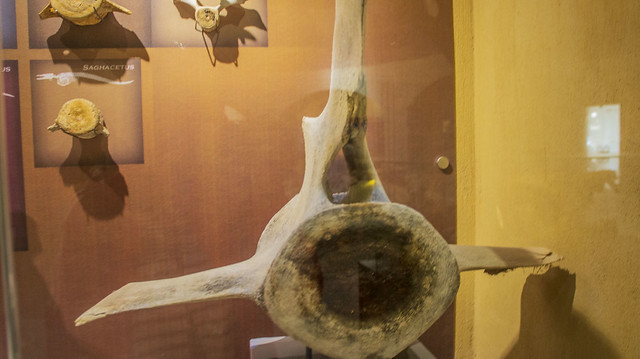 |
| Recent whale verberaate |
It is a small whale type I believe as you can see.
Now to the time when Fayoum’s desert was a rich green lively forest.
The Whale valley does not only contain fossils of aquatic creatures but also contained fossils of animals that were either extinct or evolved into some animal we already know.
For instance, the Animal of Fayoum or Fayoum’s animal or as it is officially named “Arsinoitherium”
 |
| Part of Fayoum's animal skull |
Yes, Fayoum has its own prehistoric animal named after it or after its name during the Ptolemaic era “Arsione” and here is how it would have looked like millions of years ago.
 |
| How the Fayoum animal looked like and it looked like a rhino |
 |
| The humerus of Fayoum animal and yes it was huge |
Arsione by its turn was the name of Queen Arsione I, the wife of King Ptolemy II Philadelphus who seems to be a character from the House of Dragons or the Game of Thrones.
I read that the controversial strong Queen lived in Fayoum and thus it was named after her. That’s Arsino while Therium means beast in ancient Greek.
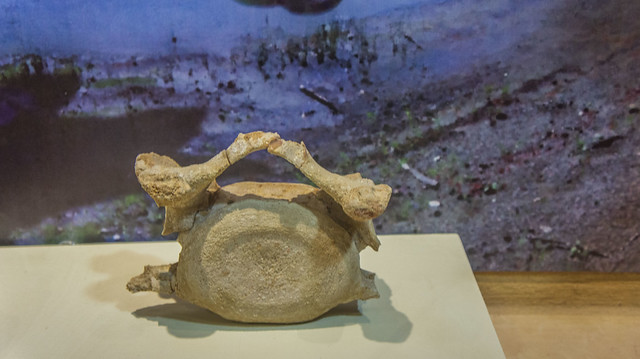 |
| The cervical vertebrate of the Fayoum animal |
Arsinoitherium was first discovered in Egypt by German Karl Alfred von Zittel, who is regarded as the father of palaeontology in Egypt.
The Arsinoitherium was also found in Jebel Qatrani formation which is at those hills.
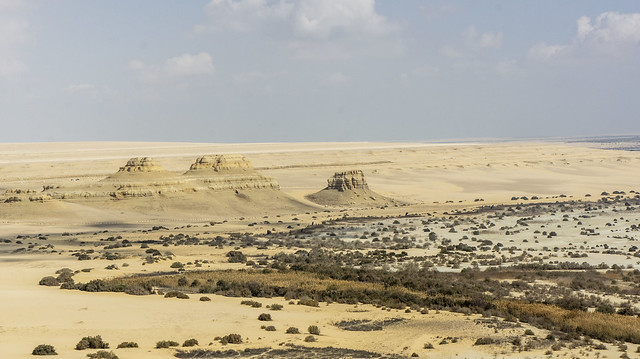 |
| I took a photo of Jebel Al-Qatarni without even knowing |
Arsinoitherium was a mammal that look so similar to the Rhinos from the outside.
The extinct animal lived mostly in North Africa when it was a rainforest.
 |
| Fayoum animal's bone at Egypt's Fossil and Climate Change Museum |
It was also found in Ethiopia and Angola as well as in Oman and Saudi Arabia.
Despite it being extinct but it is related to elephants, hyraxes and sirenians.
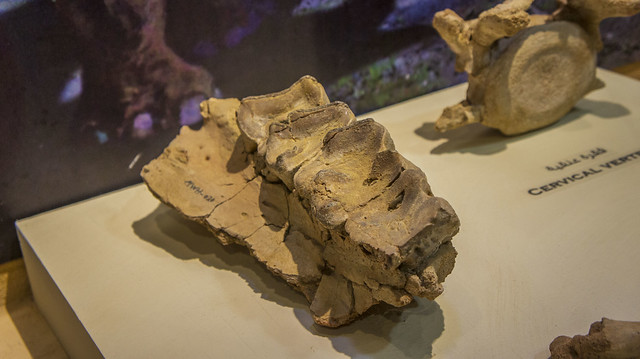 |
| I think another vertebrate of the Fayoum animal |
FYI, hyraxes and sirenians are living in Egypt to this day.
Also, do you know that once elephants or rather the great great grandfather of elephants roamed the land of Fayoum?
Here is the Palaeomastodon which lived in Africa from 36-35 million years during the late Eocene age and early Oligocene age
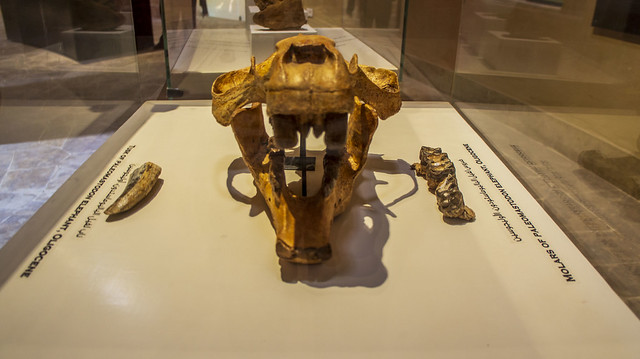 |
| Palaeomastodon's display at Egypt's Fossil and Climate Change Museum |
Here is a Palaeomastodon’s skull cast from the Oligocene age.
 |
| Palaeomastodon's skull at Egypt's Fossil and Climate Change Museum |
Here is part of a Palaeomastodon’s tusk found in Fayoum.
 |
| Tusk of a Paleomastodon elephant in Egypt's Fossil and Climate Change Museum |
Here are the molars of the Palaeomastodon elephant from the Oligocene age.
 |
| Molars of Paleomastodon elephant at Egypt's Fossil and Climate Change Museum |
Aside from elephants in the time when dinosaurs ruled the earth, there are also fossils and remains of very ancient primates.
Now, this photo includes a part of the lower jaw of Apidium Phiomense from 30 million years ago which was one of three extinct primates that lived in Fayoum.
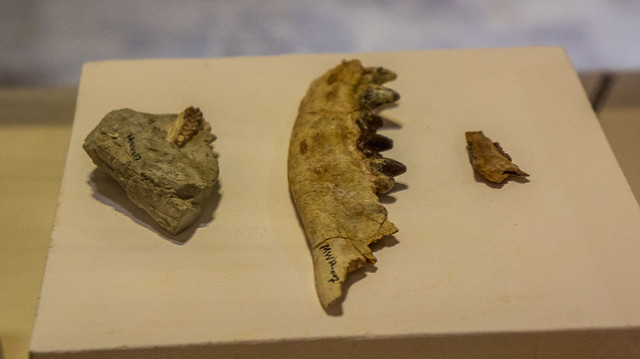 |
| parts of jaws of Apidium, some predator animal and hyrax from the Oligocene at Egypt's Fossil and Climate Change Museum |
Their fossils were found in Fayoum specifically at the Jebel Qatrani formation which needs a post and another visit alone.
In the middle, there is a partial jaw of a predator animal from 30 million years ago too.
The last one is the partial lower jaw of some Oligocene’s Hyrax which I only knew about its existence, let alone existence in Egypt from the Museum.
The Fossil and Climate Change Museum did not only introduced me to the Whale Valley but also introduced me to the famous pre-historic Nimer “Leopard” Cave.
Discovered in the 1970s the South of the Galala Plateau “The plateau is now hosting a huge city”, the Nimr “Leopard Cave” was found to be used by prehistoric people.
Inside the cave, we got the remains of leopards and other animals hunted down by those prehistoric Egyptians living in the Holocene Epoch. 
Here are a male ibex horn and a female ibex horn from the Holocene Epoch, which was from 11,700 years ago.
The fact that both ibex and leopards’ remains were found in that cave showed how humans climbed the food chain and hunted both the original hunter-predator and its food, the ibex.
Already our great great great grand ancestors were living and began to hunt down ibex to eat.
It was brand new info for me that prehistoric communities resided in those faraway plateaus away from the Nile River valley.
Here is a full leopard skeleton from the Holocene Epoch found in that cave and yes the Cave had on its walls those prehistoric cave paintings.
 |
| Full leopard skeleton from the Holocene Epoch at Egypt's Fossil and Climate Change Museum |
Here is also a leopard skull found in that cave which I do not know if it is open to visitors or now currently.
 |
| A leopard skull at Egypt's Fossil and Climate Change Museum |
I wish there were more explanations about the difference between current leopards and their old ancestors that ended up in a cave in Al-Galala.
 |
| Leopards from the Holocene era found in Leopard cave at Egypt's Climate Change Museum |
 |
| Leopard's skull from Nimer cave at Egypt's Fossil and Climate Change Museum |
A part of the lower jaw of a Nubian ibex and a part of the lower jaw of a leopard from 6200 years ago.
 |
| Partial jaws of a Nubian ibex and a leopard at Egypt's Fossil and Climate Change |
Interestingly now I ask myself why we call Nubian Ibex that name when it lived in prehistoric times in places away from Nubia close to current Suez and Ain Sokhna.
Those limbs go back from 40 million years to 6,000 years ago and they are all found in our Fayoum’s desert.
 |
| Very ancient limbs at Egypt's Fossil and Climate Change Museum |
Aside from the 6,000-years-old-limbs of ibex and goats, we got the limbs of 40-millions-years-old-cetaceans and 35-million-years-old-Anthracothere
The crocodiles which you may not know have been the least surviving reptiles to change from their prehistoric ancestors from more than 16 million years ago moreover, their oldest ancestor lived about 240 million years ago.
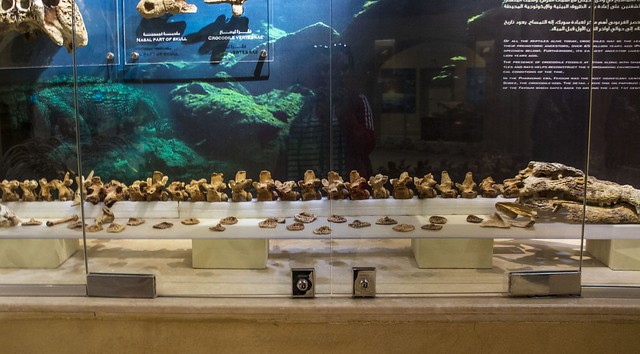 |
| Crocodile's skeleton at Egypt's Fossil and Climate Change Museum |
According to the Fossil and Climate Change Museum, this skeletal specimen actually goes back to a crocodile from Ancient Egypt which was too close to its ancestor from 16 million years ago.
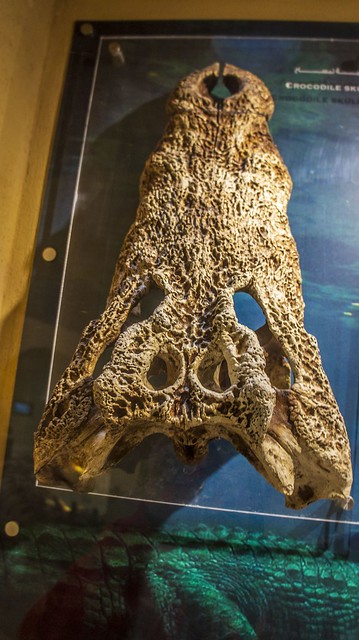 |
| Crocodile skull at Egypt's Fossil and Climate Change Museum |
Fayoum interestingly was the centre of the Sobek cult during ancient Egypt.
Older and ancient fossils of crocodiles were found in Fayoum after my visit to it in 2017.
The valley of Whales also gave us another glimpse at what it looked like 33 million years ago when it was a lavish thick forest and here some petrified wood.
 |
| Petrified tree trunk from the Oligocene period at Egypt's Fossil and Climate Change Museum |
Sorry for the shaken out-of-focus photo but I could not ignore that petrified tree trunk from the Oligocene period.
Here is another better-in-focus photo of another extremely old tree wood that survived too many moons that we can’t count easily.
 |
| Fossilized log at Egypt's Fossil and Climate Change Museum |
Here is a fossilized log of a very old tree that was found in Fayoum.
 |
| Fossilized old tree's log at Egypt's Fossil and Climate change Museum |
Those are the fossilized roots of a mangrove tree.
 |
| Fossilized roots of a mangrove tree at Egypt's Fossil and Climate Change Museum |
Mangrove trees exist now in the South of Egypt at the Red Sea’s Marsa Alam region.
Now it is my bad that I did not take a photo of the label of that balled fossil.
 |
| A fossilized thing at Egypt's Fossil and Climate Change Museum |
Here are also a couple of fossilized sea shells from the Cretaceous to Eocene time aka when Fayoum was an ocean.
 |
| Fossilized sea shells from Cretaceous to Eocene Time at the Fossil and Climate Change Museum |
They have not changed a lot.
This is our trip to the indoor museum and next time it will be inshallah at the outdoors museum aka Egypt’s fossilized Jurassic park.
All photos were taken by Sony Nex 5 with an E18-55 mm lens.
great blog very informative , my greets
ReplyDelete